9 Ways to Improve NPS Response Rates
Read More
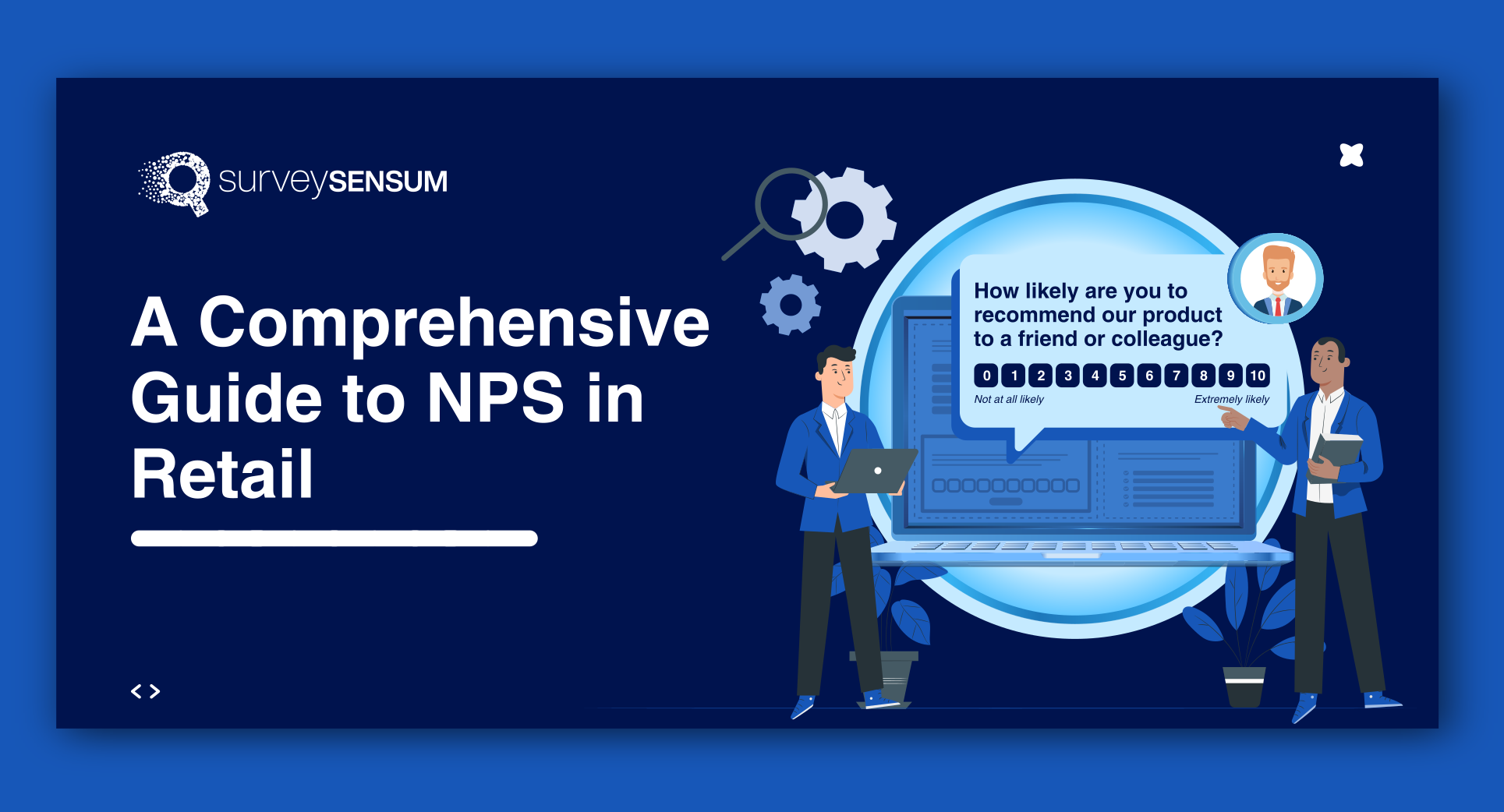
Did you know that the pandemic caused a massive shift in the retail industry, with digital penetration growing from 16% to 33% in just three months?
It’s a staggering increase, isn’t it?
And it’s not just a temporary trend – even two years later, customers are still embracing the convenience of online shopping.
But just offering your products or services online isn’t enough anymore. Customer expectations have changed drastically, and businesses need to keep up if they want to stay competitive. So how can you stay ahead of the game?
— By listening to your customers, of course!
One way to do this is by using Net Promoter Score (NPS), a simple and widely used metric that helps businesses measure customer satisfaction, benchmark their performance against competitors, and identify areas for improvement.
But don’t just take my word for it – the stats speak for themselves.
In this guide, we’ll go into more detail about the benefits of using NPS in retail, how to calculate and improve your score, and best practices for using this powerful metric to build stronger customer relationships.
So let’s dive in and learn more about how NPS can help your business thrive!
NPS, or Net Promoter Score, is a customer satisfaction metric that measures the likelihood of customers promoting your company, service, or products.
By conducting an NPS survey, you can understand what percent of your customers are promoters, passives, and detractors. To give you an overview of them,

Though we need to tap into all three, the priority should be the detractors. Because they are the ones that had the worst experience with you and will leave at the earliest!
You should attend quickly to their feedback, understand where you have gone wrong, and rectify it at the earliest.
Customer satisfaction and loyalty are 2 driving factors for retail businesses as they depend heavily on repeat customers and positive word-of-mouth recommendations to drive sales and grow their customer base.
With the NPS tool, a retail business can measure its customers’ satisfaction and loyalty, identify areas that need improvement, and develop strategies to improve customer experience.
Some reasons why you should measure NPS in retail include:
You may have heard of the Transactional Net Promoter Score (tNPS) survey that many retail businesses use after every customer transaction. But is it really the best way to measure customer loyalty and build healthy relationships?
Think about it: can someone really recommend a business after just one visit?
Probably not!
That’s why we suggest using a different approach — Relationship Net Promoter Score (rNPS) survey.
Using rNPS, retail businesses can measure loyalty and build healthy relationships with customers over time.
The best time to launch an rNPS survey is after a customer has made 3-4 visits to the store or once every 6 months.
This approach allows businesses to gather meaningful data that accurately reflect a customer’s overall experience with the brand rather than just a single transaction.
By using rNPS to measure customer loyalty and build relationships, retail businesses can gain a better understanding of their customer’s needs and preferences. This, in turn, can lead to a better customer experience, increased customer retention, and, ultimately, growth.
Learn more about retail survey questions.
Now that you have launched the survey and gathered the feedback, it’s time to calculate the NPS Score.
Calculating NPS in the retail industry is the same as any other NPS calculation.

The general formula for calculating NPS is the difference between the percentage of promoters and detractors. So the first step in calculating your NPS is to conduct an NPS survey. The survey can include questions like,
Customers responding on a scale of 9-10 are promoters, 7-8 are passives, and 0-6 are detractors.
So if a company surveyed 200 of its customer and got the following results –
Then the percentage of promoters and detractors will be –
This means the NPS score will be,
NPS score = 50 – 25= 25
It’s that simple. Now, we also provide an NPS calculator, where you can just add the number of promoters and detractors to get your score. Try our NPS calculator now!
Or follow up on the link to learn about how to calculate your NPS score in detail.
Once you have got your NPS score, the next question you should ask is whether your NPS score is good or not. Read on to know more.
A good NPS score depends on several factors. Industry and target audience are two to name. However, a positive NPS score indicates more promoters than detractors.
While this is good, the score can be considered good only if it exceeds or matches the industry average.
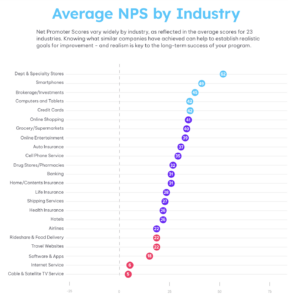
Source: Satmetrix
Here is the Average NPS Score by Industry based on the Satmetrix report of 2022, collecting almost 70,000 responses across 23 different industries.
As you can see from the given infographic, the average NPS score in online (retail) shopping is 41.
So if your retail business has an NPS score of 41 or more, then you are on the right track. Otherwise, start listening to your customers and improve your business.
To understand further whether you have a good NPS or not, you can compare your NPS score with
It should also be noted that the industry average is prone to change yearly. And since we are almost mid-way in 2023 new reports are expected soon.
Learn more about how to get a good NPS score.
Launch NPS Survey with SurveySensum – Request a Demo
Now that we know the average NPS score in retail let’s see how you can benchmark your score.
NPS benchmarking is the process of comparing your NPS with the scores of your competitors or industry benchmarks.
NPS benchmarking in retail can help you get a broader idea of how well your business is performing compared to your competitors.
It provides insights into areas where you may fall short and need improvement. And also other valuable information that can help you stay ahead of the competition and identify emerging customer needs and preferences.
Here are some steps you can follow to benchmark NPS in retail:
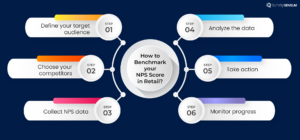
Before you start benchmarking, you need to define your target audience.
For example, are you looking to benchmark NPS for a specific product line, store location, or region? It’s essential to identify the specific area of the business that you want to measure and compare.
Identify the companies that you want to benchmark your NPS against. It’s important to choose competitors that are similar in size and market share to your company.
You can use public data sources or industry reports to identify your competitors.
To benchmark NPS, you need to collect data from your customers and competitors’ customers. It’s important to use the same survey questions and methodology for your company and competitors to ensure consistency.
Once you have collected the data, analyze it to calculate your company’s and your competitors’ NPS scores. You can also compare the scores to identify areas where your company is performing better or worse than your competitors.
Benchmarking NPS is only useful if you take action based on the results. Use the insights from the benchmarking exercise to identify areas where you can improve the customer experience.
For example, upon revising the feedback, you may see that the customers are dissatisfied with the quality of your product. You can investigate the reasons and take corrective measures to improve your product sourcing and quality.
Finally, it’s important to monitor your NPS score over time. Track your progress and ensure that your efforts to improve the customer experience are having a positive impact.
To further help you with benchmarking in retail, we have collated a list of 32 retail businesses in the US and their NPS score. Select your competitors from the list and start benchmarking.
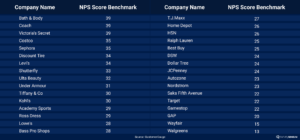
Once you have benchmarked your NPS score against the competitors, it’s time to improve it to get a competitive advantage.
If your NPS score is below the industry standards or lower than your competitors, it is essential to improve it. Following are a few pointers to help you with it.
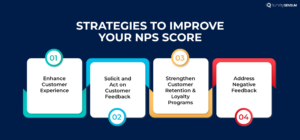
The best way to make customers your marketers is to provide the best customer experience they can get. In-app, website, or in-store, wherever your customer makes your purchase, ensure the experience is engaging.
Here are three strategies to help enhance customer experience:
Tailor your customers’ shopping experiences to meet their specific needs and preferences.
Ensure customers can easily engage with your retail business across multiple channels. The channels can be online, in-store, mobile apps, etc.
Make sure to share the surveys on channels mostly used by customers and convenient for them. For example, WhatsApp surveys are one way to increase your response rate.
Invest in employee training to encourage customer-centric culture. Foster a workplace environment that prioritizes customer satisfaction and rewards employees who consistently provide excellent customer service.
Soliciting and acting on customer feedback is crucial to improving the Net Promoter Score (NPS) in retail. By actively seeking feedback, businesses can identify areas of improvement, make necessary changes, and track the impact of those changes on NPS.
You can achieve this by following three steps:
Create opportunities for customers to share their experiences and opinions through NPS surveys. Sharing surveys after customer interactions with your business is one way to get feedback. For example – a survey about the shopping experience right after purchase.
Another way to encourage surveys is to incentivize them. You can offer discounts, free shipping, or loyalty points for attending surveys.
Once the feedback is collected, analyze it to identify the trends and patterns. Doing so can help you understand your business’s NPS score, what percentage are promoters, detractors, etc.
You can understand where the customers face problems and what they like the most about your business. Learn how text analysis can help you here.
After understanding customers’ challenges and problems, develop an action plan to rectify them. The action plan can be to improve your product features, service, or customer support.
Once the changes are implemented, monitor your NPS score and customer feedback to assess whether the changes work in your favor.
By regularly evaluating the impact of their actions on NPS, retailers can ensure continuous improvement in customer satisfaction and loyalty.
Launch NPS Survey with SurveySensum – Request a Demo
According to a study conducted by Acquia, 59% of American customers say that once they’re loyal to a brand, they’re loyal to it for life. And the best way to improve your customer loyalty is to build a robust relationship with the customers.
By investing in loyalty programs, your retail business can improve its overall customer experience. Following are a few pointers on building stronger customer loyalty.
Retail businesses can design loyalty programs that offer rewards and incentives to customers who make repeat purchases. When customers feel valued and rewarded for their repeat purchases, they are more likely to continue doing business with your company. This increases sales, ROI, and customer lifetime value.
To increase engagement and encourage loyalty, you can tailor these programs to meet different customer segments. An example of this is ‘Supercoins’ on Flipkart.

Use customer data to gain insights into customers’ behavior and preferences. In doing so, businesses can anticipate customers’ needs and offer personalized recommendations or promotions.
For example, a retail business can recommend products to customers based on their purchases or browsing history.
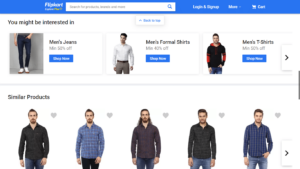
You can also create exclusive offers and promotions only available to your loyal customers. These offers can include discounts, free products, or early access to new products. By making customers feel valued and appreciated, you can increase loyalty and improve NPS.
We have already discussed the importance of addressing negative feedback. Unfortunately, detractors not only provide negative feedback but also damage your brand reputation. So, it is essential to connect with them at the earliest and convert them.
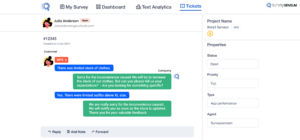
Here’s how to address negative feedback and convert detractors:
Contact detractors and understand the reasons behind their negative reviews. Then, identify the root cause of the problem and implement corrective measures quickly.
Implement corrective measures to rectify the problems faced by the customers. Consider offering a refund or discount or simply apologizing for the negative experience as well.
Once the changes have been made, inform the detractors about the same. This will make them feel valued and provide you with another opportunity to rebuild trust.
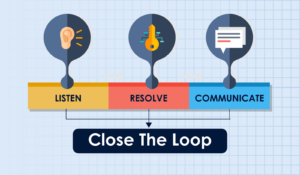
This 3 step process is called closing the feedback loop. This is an important step in addressing negative feedback as it helps
Now, you can ensure a good NPS for your retail business from the get-go itself by following some best practices.
To effectively utilize NPS in retail, consider the following best practices:
Choose an appropriate time to send out surveys, such as shortly after a purchase or interaction. This ensures that the experience is fresh in customers’ minds, leading to more accurate feedback.

Collect NPS data through various channels, such as email, SMS, in-store kiosks, or even social media, to reach a broader range of customers and gather more comprehensive feedback.
Focus on the NPS question and avoid adding too many additional questions. A concise survey is more likely to be completed and yield more accurate results.
Break down NPS scores by different demographics, store locations, or product lines to identify trends and areas of improvement. This will help you understand the factors driving customer loyalty and take targeted action to improve.
Always follow up with customers who have provided feedback, especially detractors. This demonstrates that you value their opinions and are committed to improving their experience.
Train and encourage employees to seek customer feedback and take responsibility for improving customer satisfaction. Share NPS data with staff to keep them informed about customer sentiment.
Launch NPS Survey with SurveySensum – Request a Demo
There are several limitations and challenges of NPS in the retail industry:
This happens when the focus is not achieving a high NPS score and not improving the customers’ experiences. Thus, decreasing the value NPS provides.
NPS is a powerful tool that can help retailers gauge customer loyalty and satisfaction.
By launching an NPS survey at the right time, and following best practices for implementation, retailers can unlock valuable insights into their customers’ experiences, and make data-driven decisions to improve their business.
To get started with NPS in retail, it’s important to first understand what NPS is and how it works in the context of retail. Retailers can then determine when to launch their NPS survey, how to calculate and benchmark their NPS score, and what strategies to use to improve their score.
While NPS can be a highly effective tool, there are limitations and challenges to its implementation in the retail industry. However, with careful consideration and planning, retailers can overcome these obstacles and leverage the power of NPS to enhance their customer relationships and drive business growth.
So, what are you waiting for? Leverage the best NPS software and start using NPS to enhance your customer experience today!
Choosing an ideal NPS tool for your business is a challenging task, especially because of the plethora of tools available.
Don’t worry. We have got you covered.
Take a look at the 15 best NPS tools of 2023 for you to choose from.
Following are some key characteristics of reliable NPS software.
SurveySensum provides all of the above with multilingual surveys, WhatsApp surveys, and more. The tool’s free version offers unlimited users, surveys, and questions.
You can try out the free version to create your NPS survey with 3 easy steps.
STEP 1: Log in to the SurveySensum platform.

STEP 2: Click on ‘Create a survey’, and select the NPS survey template.
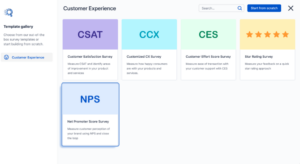
STEP 3: Customize the survey according to your brand’s needs, and when finished, click on- Share Survey.
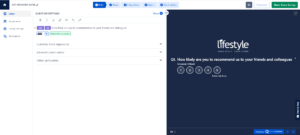
You will start getting real-time feedback in your dashboard right after you share the survey.
Launch NPS Survey with SurveySensum – Request a Demo
Accordion to the research done by Satmetrix, as of 2022 the average industry NPS score for an online (retail) business is 41.
Retail businesses should measure and analyze their NPS regularly. Ideally, quarterly or biannually is best to track changes in customer satisfaction and identify areas for improvement.
NPS is a quick and effective way to gauge customer feedback and track changes in customer sentiment over time. It also helps measure customer loyalty and satisfaction and identify areas for improvement.
